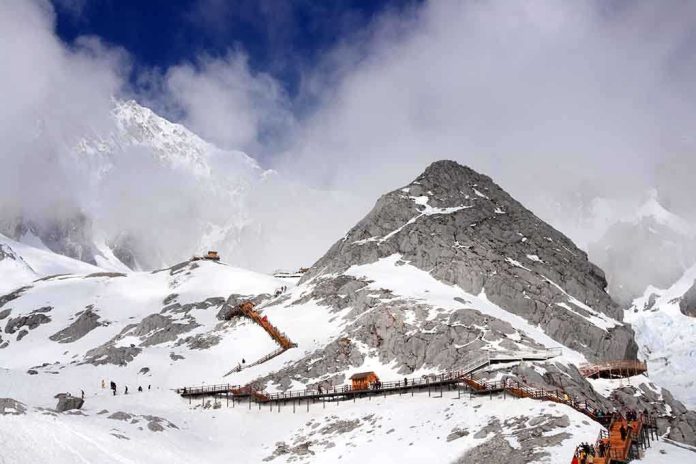
What compels over twenty people—many seasoned, some new to the trail—to risk a treacherous ascent, only to face a night that could have ended in disaster, but instead became a testament to human grit and the raw unpredictability of nature?
Story Overview
- More than 20 hikers stranded by a sudden snowstorm on a New Hampshire mountain were rescued in a tense, all-night operation.
- New Hampshire Fish and Game, local SAR volunteers, and police executed a high-stakes rescue across dangerous, weather-battered terrain.
- Despite hypothermia cases, all hikers survived—spotlighting both the risks of autumn hiking and the resilience of New Hampshire’s emergency response system.
- The event is reigniting debates on hiking safety, preparedness, and potential regulatory changes as outdoor recreation surges.
When Adventure Turns to Ordeal: The Timeline of a Rescue
October 27, 2025, began with crisp air and blue skies. By mid-afternoon, the first flakes fell on the ridges of the White Mountains, catching more than 20 hikers—ranging from out-of-state thrill seekers to local regulars—off guard. Within hours, visibility vanished, temperatures plummeted, and a routine trek morphed into a survival scenario. Emergency calls pulled New Hampshire Fish and Game, Androscoggin Valley Search and Rescue, and Mountain Rescue Service from their stations into a rapidly worsening blizzard. By dawn, every stranded hiker was accounted for, hypothermic but alive, ferried to safety through a gauntlet of ice and wind that humbled even veteran rescuers.
Rescue teams described the operation as a logistical puzzle—moving more than twenty shivering, exhausted hikers down slick, stone-strewn trails in darkness. The Presidential Range has claimed lives before, and the margin for error was razor-thin. Radios crackled with updates as SAR volunteers, many with decades of experience, navigated treacherous drop-offs and snowdrifts, pausing only to administer first aid or rewarm a group huddled for shelter. Local law enforcement established command posts and coordinated medical support at trailheads, while family members waited for news with mounting anxiety. The rescue’s success, officials later stressed, came from years of cross-agency training and the hard-earned intuition that only the White Mountains can teach.
Why October Remains the Most Dangerous Month
Late October in New Hampshire’s mountains is notorious for its meteorological ambushes. Hikers often underestimate how fall foliage season can give way in hours to winter’s first assault. The National Weather Service had flagged potential high winds and snow, but as outdoor participation skyrockets post-pandemic, many newcomers ignore or misunderstand such warnings. This incident mirrored past emergencies—like the 2019 blizzard rescue or the 2022 Franconia Ridge airlifts—each reinforcing the brutal lesson that even experienced hikers can’t outpace the mountain’s mood swings. The White Mountains’ growing popularity, paired with the democratization of adventure culture, is drawing more people—sometimes ill-prepared—into the jaws of risk.
Rescue infrastructure in New Hampshire is robust but under continuous strain. Fish and Game officials lead every major operation, supported by specialized volunteers whose local expertise is irreplaceable. The cost of these missions—both financial and human—is rising. Annual reports show a steady drumbeat of rescues, many linked to sudden weather changes and insufficient planning. As one rescue coordinator put it, “We prepare for the worst every season, and every year the mountains try to surprise us anyway.”
Fallout: Who Pays, Who Learns, and What Changes Next?
For the hikers, the ordeal ended with bruises, mild frostbite, and a new respect for the mountain’s power. Some now face medical bills or fines for inadequate preparation—a controversial but increasingly common response. For the rescue teams, the operation was a test of endurance and coordination, with implications for future training and resource needs. Local tourism officials worry about the story’s impact: Will it scare off visitors or simply remind them to hike smarter?
The debate over responsibility is heating up. Some experts argue for tighter regulations—mandatory safety briefings, permits, better trail signage—while others insist on personal accountability and education. Outdoor industry leaders see a marketing opportunity for safer gear and guided tours, while lawmakers debate whether to increase funding for SAR or impose new requirements on hikers. Underneath, a shared recognition is growing: the intersection of human ambition and nature’s unpredictability is only becoming sharper as climate shifts and participation rises. Every rescue is a warning, and every warning is a chance to avert the next crisis—if only people are willing to listen.









